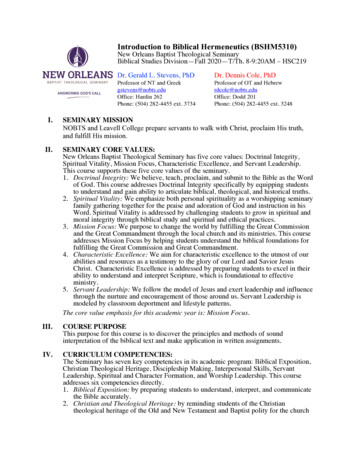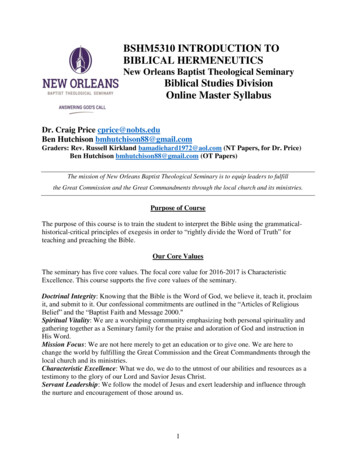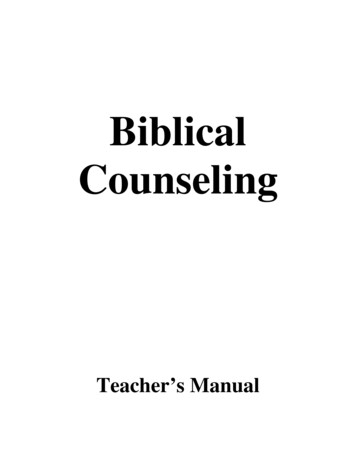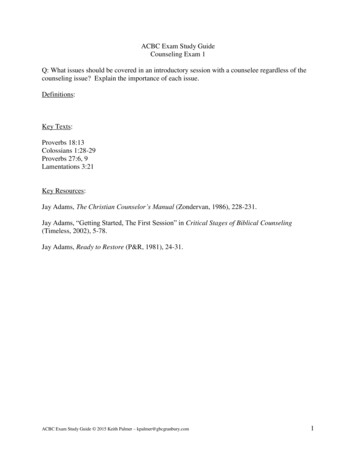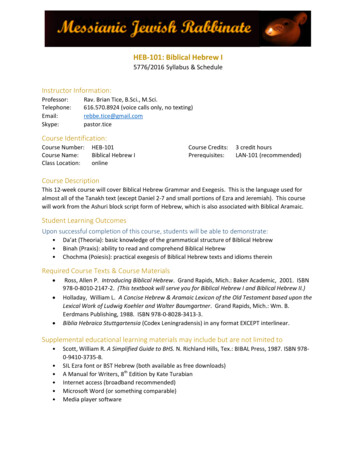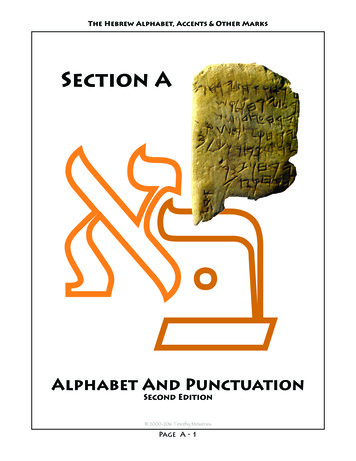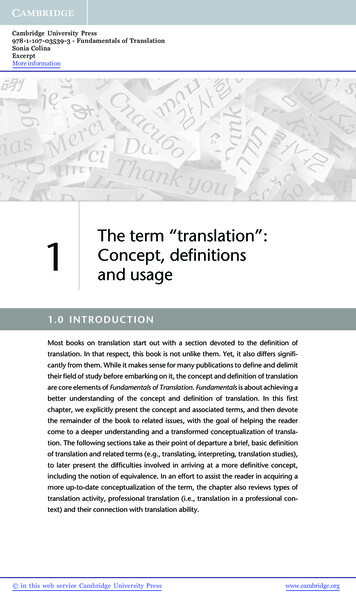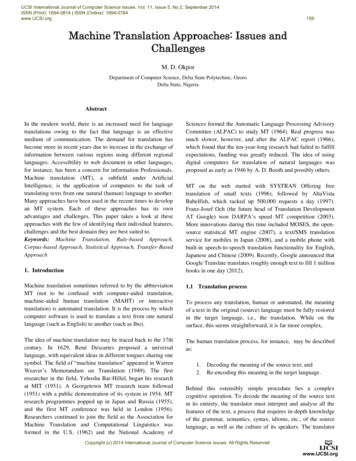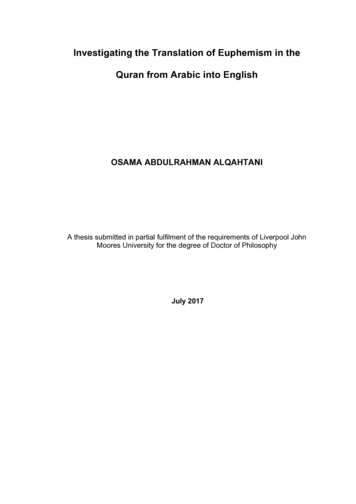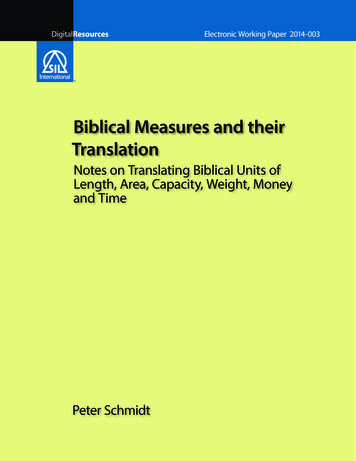
Transcription
DigitalResourcesElectronic Working Paper 2014-003 Biblical Measures and theirTranslationNotes on Translating Biblical Units ofLength, Area, Capacity, Weight, Moneyand TimePeter Schmidt
Biblical Measures and their TranslationNotes on Translating Biblical Unitsof Length, Area, Capacity, Weight, Money and TimePeter SchmidtSIL International 2014SIL Electronic Working Papers 2014-003, February 2014 2014 Peter Schmidt and SIL International All rights reserved
AbstractThis paper presents an overview of all units of measurement in both the Old and New Testaments. And,as a help for translators, it specifically provides the modern equivalent for each measure. Specialattention is also given to the differences between the short and the long cubit, as well as a discussionabout the sizes of the ephah and the bath. In addition, this paper argues that the acknowledgeddifferences between pre- and postexilic units of measurement should be taken into consideration in anytranslation, even if precise definitions may not be possible. Furthermore, it proposes that measures ofcapacity should be rendered as certain measures of weight, if this is more acceptable in the host culture.Lastly, while the usage of metric equivalents is seen as fitting in certain situations, this approach mayalso raise unique problems, and these are addressed. Some of these problems include dealing withsymbolic numbers and verses which, in the original text, explain one measurement term by usinganother, and thus function as a kind of footnote. Other issues of translation are also touched upon aswell; however, what is not included is a discussion of those discrepancies that seem to exist betweensome passages of I & II Chronicles on the one side, and their parallel texts in I & II Kings on the other.ii
ContentsAbstractAcronyms and abbreviationsIntroduction1Length and distance1.1 Table and remarks1.2 Additional measures of length1.3 “A day's journey”1.4 The length of the “short cubit” and the “long cubit”1.5 On translating length and distance1.6 Symbolic numbers2Area3Capacity3.1 Table and remarks3.2 Numbers 11:31 & 32: How many quails?3.3 Ruth 3:15: Which “measures”?3.4 Haggai 2:16: Fifty “pressings”3.5 Additional measures of capacity3.6 Capacity versus weight—Or: “How heavy is a liter of flour?”4Weight4.1 Table and remarks4.2 Ezekiel 45:10–15: “20 shekels, 25 shekels, 15 shekels”4.3 Additional measures of weight4.4 Daniel 5:25 and the verses that follow: “Mene mene teqel uparsin”4.5 The “sanctuary shekel” and the “king’s weight”5Money5.1 Old Testament5.2 New Testament—table and remarks5.3 Additional measures of money5.4 On translating monetary values6Time6.1 “Hours” and “night watches”6.2 Other times of the day6.3 “Days” in the sense of “a long-time”6.4 Years and Months—table and remarks6.5 “Seven times” and “time, times, and half a time” in Daniel and Revelation7Translating measurements—a few additional considerations7.1 Original measurements versus modern equivalents7.2 On translating “inner-biblical footnotes”Appendix A: Annotated ReferencesAppendix B: Correlation of modern measuresAppendix C: Indicesiii
Acronyms and abbreviationsEnglish REBRSVTEVAnchor BibleContemporary English VersionEnglish Standard VersionGod's WordJerusalem BibleNew American BibleNew American Standard BibleNew Century VersionNew English TranslationNew International VersionNew Jerusalem BibleNew Living TranslationNew Revised Standard VersionRevised English BibleRevised Standard VersionToday's English VersionGerman TranslationsGCLHFAGerman Common Language Translation ("Gute Nachricht Bibel")Hoffnung für alle ("Hope for All"), translation into colloquial GermanReference IDOTTENPRHSDBHTBTTHTOTCWBCWSBAnchor Bible DictionaryBulletin of the American Schools of Oriental ResearchBiblia Hebraica QuintaBiblia Hebraica StuttgartensiaDictionary of Classical HebrewHebrew and Aramaic Lexicon of the Old TestamentHebrew Old Testament Text ProjectInternational Critical CommentaryInternational Standard Bible EncyclopediaGreek-English Lexicon by Louw and NidaNew Bible DictionaryThe New International Commentary on the Old TestamentNew International Dictionary of Old Testament Theology and ExegesisDer neue Pauly. Enzyklopädie der AntikeRealia HandbookSemantic Dictionary of Biblical HebrewThe Bible TranslatorUBS Handbooks for TranslatorsTyndale Old Testament CommentariesWord Biblical CommentaryWuppertaler StudienbibelFor details, see Appendix A.iv
ics.v.vrss.comparecentimeter(s)following pagesfigurativefootnotefromSeptuagintMasoretic Textmeter(s)New TestamentOld TestamentPeter Schmidt (that is, I, the author’s personal comment)readspelling/grammatical error copied as originally writtenunder the wordversionsNote: Emphases marked by italics, either within short quotes in the text or set off as extended quotes, aremine. In addition, words that appear within brackets in the same environments are my interpretation ofthe contextual referent. Translations of quotes from works written in German are mine as well. (PS)
IntroductionThe topic of Biblical measurements can be confusing to the translator. To begin with, there areapproximately forty units of measurement mentioned in the Bible, most of which are not used today andtherefore generally unknown. Then, not all measures fit into one system and differing systems exist sideby side. Furthermore, scholars generally lack specific evidence to determine the value of each termprecisely and consequently today’s translations do not all follow the same system of conversion. Nor doesit help that American, British and International metric systems are all used in Biblical literature whengiving modern equivalents.In translating the entire Bible, one can take the pragmatic approach and follow one widely-knowntranslation throughout. However, for those who want to make more informed decisions for thetranslation on which they are working, it seems advisable to first establish a framework for rendering thevarious measures, rather than treating each on a case by case basis. The down side of taking that route,of course, is consulting different resources from different Biblical works and perhaps ending up withcontradicting data in the translation! This would be especially true, if a number of people work ondifferent Biblical books.As always in translation, one needs to take two steps and for both of these steps this paper should behelpful. First, an effort is made by the translator to collect the data available from various referenceworks for determining the value of an ancient measurement. This, I have attempted to do in this paper inorder to save the translator from doing his own research for each measure.1 Secondly, the actual value ofeach measure needs to be translated; that is, communicated meaningfully into the host language. Thus,several aspects regarding this task are also discussed and suggestions presented.Before leaving the introduction, I need to add: In this paper I do not pretend to contribute anythingparticularly new to the research that has already been published regarding weights and measures, butrather I present the data—and arguments—from relevant books as far as they seem necessary for makinginformed translation choices. Some simplifications, however, are unavoidable. Lastly, the fewoccurrences of terms of measurement in the Aramaic sections of the Old Testament are included, butthose problems regarding numbers cited in I & II Chronicles—which seem to mismatch those in I & IIKings—could not be dealt with at this time.11.1Length and distanceTable and remarksThe ’( ַא ָמּה amâ) “cubit” is by far the most frequently used measure for length in the Old Testament, andthus will serve as the basic unit in this paper. Table 1 shows the system of units related to the cubit. Formore on the length of the cubit, however, see section 1.4.Perhaps a caveat is warranted here in that scholars at times admit that there are many open questions in thisprocess.11
2Table 1handbreadthspancubit ֶטפַח ז ֶֶרת ַא ָמּה 1/241/61/211.8757.522.545OTtermsfingerratio tocubitin cmin inches ֶא ְצבַּע 0.732.92NT term8.7517.5longcubitreed1 cubit &1 handbreadth6 longcubits20.512352.5 ָקנֶה 315πῆχυςThe ’( ֶא ְצבַּע eṣba‘) “finger” as a measure only occurs in Jeremiah 52:21 as “four fingers”—which is equal toa handbreadth.The ( ֶטפַח ṭepaḥ) / ( טֹפַח ṭōpaḥ) “handbreadth” is the breadth of the four fingers; that is, the breadth of thepalm at the base of the fingers. The form ( ַט ְפחָה ṭapḥâ) is used figuratively of a lifetime in Psalms 39:5[MT6].The ( ז ֶֶרת zeret) “span” is the distance between the stretched-out extended thumb and the tip of one’s littlefinger.The ’( ַא ָמּה amâ) or πῆχυς (pēchus) “cubit” is the distance from elbow to fingertip.The ( ָקנֶה qaneh) “reed” denotes both the reed as a plant; and, derived from that, a measuring rod of adefined length. In this latter sense it only occurs in Ezekiel.1.2Additional measures of lengthThe ( גּ ֹ ֶמד gōmed) is found only in Judges 3:16 in describing Ehud’s sword. Although the exact meaning isunknown, some read it as a “cubit.” This interpretation certainly is a possibility. Brown-Driver-Briggs inBrown et al. (1906) state: “ cubit (fr. elbow to knuckles of clenched (contracted) hand )” HALOT,however, notes: “short cubit., ? span.” In any case the sword was short enough to be hidden under one’sclothing, but long enough to be driven through a “very fat man,” that is, Eglon’s belly and back.The phrase שׂדֶ ה ָ ( ְכּ ַב ֲחצִי ַמ ֲענָה ֶצ ֶמד kebaḥaṣî ma‘anâ ṣemed śādeh) “ in about half of a furrow in an acre ofland,” which occurs in I Samuel 14:14, requires some interpretation. NASB renders the verse as: “Thatfirst slaughter, which Jonathan and his armor bearer made was about twenty men within about half afurrow in an acre of land.” Then, TH comments:FOX. follows the MT but includes within parentheses information that seems to be implicit:“(over) about half a furrow (that) a brace [ yoke] (of oxen might plow) in a field ” CEV states:“before they had gone a hundred feet,” although some commentators estimate the distance to bemore like fifteen or twenty meters (Klein, Driver). FRCL has a more general expression, namely:“in a very restricted space.”2Note that both here and below I have attempted to reduplicate each quote—extended or otherwise—exactly as itoriginally appeared in the source text. This includes abbreviations, bold or italicized fonts, single or double quotes,etc., even if any one of them may not appear to be a generally accepted norm.2
3Before we leave the translation of “half a furrow,” I suggest that the translator consult other Englishtranslations for additional ideas of rewording this phrase; for example, NCV renders it as: “over a halfacre of ground,” which turns the distance into the size of a prescribed area.The use of a ( ֶחבֶל ḥebel) “measuring line” for measuring land is attested to several times in such books ofthe Old Testament as Psalms 16:6 (used figuratively); 78:55; Amos 7:17; Zechariah 2:1 [MT5]; Micah2:5; cf. II Samuel 8:2. However, we have no indication that there was a standardized length for themeasuring line.The nautical unit σ̓ργʋɩά unit (orguiá) “fathom,” which occurs only twice in Acts 27:28, matches a man’sarms stretched out horizontally. It is generally understood to be approximately 1.80 meters (NP: 1.85meters). For the Acts reference above, LN suggest: “ about 40 meters. about 30 meters.”A στάδιος (stádios) or “stade” consisted of 600 feet. Since the “foot” differed in distinct regions, the stadediffered too; namely, from 178 to 192 meters. For the New Testament many favor the Alexandrian stademeasuring 185 meters, although this too is debatable. Thus, in a verse like Luke 24:13 in NIV we have:“Emmaus, about seven miles from Jerusalem,” which one might also render as: “ about 11 kilometers.”A ὁδός σαββάτου (hodós sabbátou); that is, “a Sabbath day’s walk” was, according to Jewish sources,2,000 cubits long, which matches some 900 meters. However, others arrive at anywhere between 800and 1,100 meters. The footnote on NIV’s rendering of Acts 1:12; namely, “They returned to Jerusalemfrom the hill called the Mount of Olives, a Sabbath day’s walk from the city,” states: “This is about 3/4 ofa mile (or about 1,100 meters).” Another expression that could equally be used in the text is: “ close to/ about one kilometer.” This is particularly acceptable, if the translator wants only to express thedistance. However, he/she might also want to take into consideration the discussion regarding this termunder section 7.1 “Original measurements versus modern equivalents”.The Roman μίλιον (mílion) “mile” was 1,479 meters long. But in the only place where the mile occurs,which is Matthew 5:41, NIV renders it as: “If someone forces you to go one mile, go with him twomiles.” The exact distance does not seem to be in focus, although TH points out: “One mile waspresumably the distance a Roman soldier could force a Jew to carry his equipment.” In this case,something like “a kilometer” should work just as well in most translations.1.3“A day's journey”In the expression ( דֶּ ֶרְך יוֹם derek yôm) “the journey of a day,” time is also used to measure approximatedistance. Thus, journeys or walks of one, three, seven or eleven days are mentioned in Genesis 30:36,31:23; Exodus 3:18, 5:3, 8:27 [MT23]; Numbers 10:33, 11:31, 33:8; Deuteronomy 1:2; I Kings 19:4; andII Kings 3:9. For example, in Deuteronomy 1:2 it reads: “It takes eleven days from Horeb to Kadeshbarnea.”In ISBE, under the term: “day’s journey,” we see:The distance traveled must of course differ largely according to the difficulties of the way. Therate of travel with a loaded mule is now commonly reckoned at 3 mi. (about 5 km.) per hour, anda day's journey is generally eight hours. Hence a day's journey is about 24 mi. (40 km.) and thismay be taken as a fair estimate for Bible times.3NET gives a rather lower estimate in its footnote on Deuteronomy 1:2, where it states: “An eleven-dayjourney would be about 140 miles (233 kilometers)4”—thus 12.7 miles or approximately 20 kilometers3NB: 1 mile equals 1.609 kilometers.Note that 1 km. is usually considered to equal 0.62 miles, or 1 mile matches 1.61 km. So, mathematically speaking,140 miles would equal 225 km., not 233 km. I am not sure what the basis for NET’s conversion is.4
4per day. In the New Testament the only place with similar wording is found in Luke 2:44. NASB reads:“[His parents] supposed him to be in the caravan and went a day’s journey.” NIV translates this as:“Thinking he was in their company, they traveled on for a day.” And TH comments:Jewish sources differ considerably as to the length of a day’s journey, ranging from 15 to 40 miles5but it is safe to assume that a caravan of pilgrims would not do more than 15-20 miles a day.In most cases a translation of the expression “a day’s journey” will communicate just fine and is to bepreferred over indicating a concrete distance in kilometers, which cannot be definitively confirmed.1.4The length of the “short cubit” and the “long cubit”The cubit is historically considered the distance from elbow to fingertip. However, some scholars debatehow long the standardized unit of this measurement actually was. ISBE, while cautious with interpretingother measures, proposes 44.4 centimeters as “generally accepted,” and builds this on the evidence thatwe have from the Siloam tunnel in Jerusalem and other similar constructions. Likewise, NBD gives thefigure of 44.45 centimeters as “generally accepted” and sees various present-day observable buildings assupporting their conclusion. However, ABD—seemingly reluctant to give precise equivalents—holds that“ 50 cm recommends itself as a rule of thumb., because it is the midpoint of values (44 to 56 cm)derived from the ‘natural’ cubit.” But ABD does not explain to us why the “natural” cubit should governthe interpretation of the unit, when there is the above mentioned archeological evidence.For the cubit in the New Testament, NBD explains that there were two different measurements: theRoman cubit of 44.40 centimeters, which is virtually equal to the Old Testament one; and the Philetariancubit of 52.50 centimeters. Based on what Julian of Ascalon (Hakin 2001) writes, the latter wascustomary in Palestine, and this is probably the one referred to in New Testament writings. But ISBEapplies the Roman cubit without discussion. ABD states that the length of the cubit in the New Testamentis “ as uncertain as the Old Testament cubit,” although Julian of Ascalon is mentioned in the samearticle.Since the translator does not have the option to leave things undecided, and since some evidence—however contestable it might be—is better than an approximate, it seems appropriate to go by a cubit of45 centimeters, or approximately 17.5 inches in the Old Testament; and 52.5 centimeters, orapproximately 20.5 inches in the New Testament. Parenthetically, this also happens to match the OldTestament’s long cubit. The figures in Table 1 are calculated in such a way that the short and the longcubit are given as exactly as possible, while still coming up with reasonably round numbers incentimeters and inches respectively.In addition to the problem of defining the cubit precisely—or, as part of it—there is the fact that, in theAncient Near East, people utilized common (or: short) cubits and long (or: royal) cubits. This becomesespecially evident in Ezekiel 40:5, as well as 43:13. Thus NIV has:The length of the measuring rod in the man’s hand was six [long]6 cubits, each of which was acubit and a handbreadth.In Israel, the long cubit likely consisted of seven handbreadths, and the ordinary one of six, which can beseen in Table 1. The question is where in the Old Testament text does “cubit” mean this long one andwhere does it mean the short one?Lovett (2005), who is mainly concerned with issues concerning the dimensions of Noah’s Ark, isconvinced that “ the evidence is definitely in favor of a “royal” sized cubit for Noah’s Ark.” He states:56cp. Strack-Billerbeck II, 149.Note that the word "long" is not in the Hebrew text.
5“Noah’s Ark was constructed a long time before the nation of Israel appeared on the scene. That is, Noahwas no Hebrew!” It is therefore not appropriate to take the common Hebrew cubit as the most likelyinterpretation for Genesis 6:15. In fact, Lovett states in his abstract:According to a straightforward reading of the Bible, the Babel tower should have inherited Noah’scubit. From there, the same cubit would be transported to the fledgling nations, explaining whythis type of lineal measure is so widespread so early.And further below he explains:It is difficult to imagine how a supposedly non-anatomical measure could turn up in differentnations with distinct subdivisions yet have a suspiciously similar length. Looking in the ancientNear East (ANE) for the best clues, we find the longer cubits employed in the earliest major worksin Egypt and Babylon. This makes it a natural choice for the cubit of Genesis 6:15.Then Lovett (2005) further argues that there is no evidence that the common cubit predates the royal, asif the oversized royal cubit was introduced when standardization became necessary. In fact, from myperspective, the royal cubit is so unsuitable under practical considerations that it is more likely thatpeople switched to the “natural” cubit later. A possible reason for the origin of the royal cubit is that itderives from the people who lived before the Flood; that is, those who may have been taller than theaverage person in later Biblical times or today for that matter. To put it the other way round: the shortcubit was too short to fit Noah’s physical size. And citing Lovett (2005) once again: “In Egypt, the royalcubit is clearly observed well before any ‘certain vestiges of the small cubit have been recorded.’”There are two Biblical references that are meant to give some indication about the nature of the cubit atthat time. However, both of these references are rather difficult to read. The first one is found inDeuteronomy 3:11 (NASB:)For only Og king of Bashan was left of the remnant of the Rephaim. Behold, his bedstead was aniron bedstead; it is in Rabbah of the sons of Ammon. Its length was nine cubits and its width fourcubits by ordinary cubit.The phrase ( ְבּ ַא ַמּת־אִישׁ be’amat-’iš), which NASB translates: “by ordinary cubit” is literally: “by the cubit ofa man,” and often understood to refer to the short cubit.7 HALOT states:usual cubit two spans8 or six or seven hand-breadths9ISBE (vol. 4 p. 1048) mentions:.but the word ̓ îš, “man,” can also mean “an important man,” and so Tgs. Onkelos and Neofititranslate the phrase “by the royal cubit” (cf. Pesh. “by the hero's cubit”; Tg. Pseudo-Jonathan “byhis own cubit,” i.e., as measured by Og's own larger-than-normal forearm).One argument in favor of this view is that the passage talks about a giant and a king. But the point of thisexplanatory note in the text is to enable the reader to picture the size of Og's bed (or sarcophagus). Thus,it makes sense to assume the ordinary cubit, which was commonly known. Because explaining the size ofthe giant's bed by the size of a giant's cubit would mean explaining the unknown by the unknown.In Lovett’s (2005) view, it is striking that Moses never qualifies the kind of cubit to which he refers,except in this case, which clearly refers to an object that can still be inspected at the time of writing. So,all the other measurements—both those referring to historic objects like Noah’s ark and those referringto the construction of a sacred place like the Tabernacle—would be understood as using the other cubit;namely, the royal one.for example: by AB, NET, NLT.which makes it equal to the short cubit.9which keeps interpretation open to understand a long cubit!78
6The second reference is in II Chronicles 3:3 (NIV):The foundation Solomon laid for building the temple of God was sixty cubits long and twenty cubitswide (using the cubit of the old standard).There is no absolute certainty whether, at the time of the Chronicler’s writing, “the old standard”—or:“former/first measure”—was the long one or the short one. According to Lovett (2005), it would not belogical to assume it to be the “usual” cubit of the Hebrews, as it is found in archeological evidence likethe Siloam tunnel, because that would not justify such a remark. But considering that the Chroniclerwrote some 500 years after the events occurred, the “former standard” might well mean “the standardmeasure of Solomon’s times.” And this is most likely the correct understanding, since the parallel text inI Kings 6:2 uses the same figures—and the writer of Kings probably used those measures used by hiscontemporaries. Thus, “old” here likely means “short.”The next question is: which standard was used in the other occurrences of “cubit” in I & II Chronicles?Firstly, the text of II Chronicles 6:13 is not found in I Kings, but nevertheless refers to the dedication ofthe Temple, and thus, the same short cubit as in II Chronicles 3:3 is likely to have been in view.Secondly, II Chronicles 25:23 is not related to the Temple, but has a parallel text in II Kings, and clearlyuses the same measure as there: again the short one. This leaves us with one reference, namely in IChronicles 11:23, where we need to decide whether the author applied his own contemporary cubit,which would be the long one, or the same short one as in other places. For simplicity in translation, onewill likely assume the short one. 10To my knowledge, the only reference work that actually suggests where to assume which cubit is in viewis NIDOTTE. 11 In his article in NIDOTTE Fuller (1997) mentions the Mishnah and Talmud recognizingthree different cubits for the Biblical period and among these, yet additional distinctions. I shall notrepeat those details here, but only to state that for the “postexilic” period the cubit represented 52centimeters, which Fuller sees, as used in Ezekiel, Esther, Daniel, and Zechariah, but not in Ezra. Inaddition, for Deuteronomy 3:11 and II Chronicles 3:3, he also proposes the short one.1.5On translating length and distanceWhere words like cubit, span and handbreadth already exist in the host culture, this will make thetranslation process relatively easy. Where a technical term like “cubit” does not exist, however, onemight sometimes be able to translate a descriptive term like an “arm-length.” Otherwise, in most cases,meters and centimeters will need to be used. For multiple units, one ought to start with precisemeasures.In rounding up or down, the translator needs to reconcile two needs: On the one hand is the need forprecision and a true rendering of corresponding references in the Bible. On the other hand is the need tocreate a smooth text that does not distract readers by being unduly precise, where the measurement isnot in focus. This, of course, occurs especially when the Hebrew text itself gives a rounded number, theequivalent of which cannot be determined with certainty.Let’s take the size of Noah’s Ark, as described in Genesis 6:15, as an example: Its measurements oflength, breadth and height are 300, 50, and 30 cubits respectively. If one converts these—assuming a longcubit of 52.5 centimeters—he/she gets 157.50 / 26.25 / 15.75 meters. In this environment there wouldbe no point of putting such precise figures in the text. Yet, if one rounds them up and down individually,for instance to 158 / 26 / 16 meters, the proper ratios between them are lost. Thus, in this case, it does10Note that in the length of Noah’s Ark (Genesis 6:15), for instance, applying long or short cubits results in 157.5versus 135 meters, which is not a negligible difference.11cf. see bibliography.
7seem better to work with round numbers like 150 / 25 / 15 meters, as GCL and HFA have done. Asalways, the translator will have to explain his basic premise somewhere below the text. An exampleinvolving weights would be Numbers 7:13 and the verses that follow, where there is talk of two vesselsof 130 and 70 shekels respectively.While discussing the cubit in particular, in light of the preceding paragraph, we expose a challenge toevery translator: Is one supposed to distinguish between short and long cubits? If so, I present threeoptions:a) The first option is using the host culture’s equivalent for the word “cubit” in all instances. This, ofcourse, will only work if there is an adequate expression in the host language, which is meaningful to theaverage reader. However, in any instance a clarifying note, whether in the form of a footnote orsomething integrated into the introduction or glossary, may be needed to explain the existence ofvarying standards of the cubit, and their modern equivalents.For example, in the footnote for II Chronicles 3:3 NLT, the translators have explained for the reader thatthey assume a short cubit, whereas the translators for the NIV Study Bible assume the long one. 12 NLT, inits first edition (1996) has footnotes in Ezekiel stating: “In this chapter, the distance measures arecalculated using the Hebrew long cubit, which equals 21 inches or 53 centimeters.” The footnote of theNIV Study Bible on Ezekiel 40:5 reads: “In using the long cubit., which was older than the shortercubit., Ezekiel was returning to more ancient standards for the new community.” Likewise the TurkishBible 13 in its appendix, points out that in Ezekiel 40–48 the long cubit applies.b) The second option is using modern equivalents, assuming the same cubit everywhere. This would bethe pragmatic approach. And, since it cannot be determined with certainty which cubit is to be applied inall references, one reckons with the same equivalent everywhere, (except in Ezekiel 40:5, where the textstates: “long cubits, each of which was a cubit and a handbreadth).” This will likely require some note(s)about the underlying simplification.NIV in their Table of Weights and Measures gives “18 inches” and “0.5 meter” as approximate equivalentsand so do LN for the New Testament. This is helpful in that it gives the reader a rough idea of themeasurements involved, but it can also be misleading in that it leaves the impression that a cubit couldbe anywhere between 46 centimeters and 50 centimeters long, whereas in reality one cubit was 44–45centimeters long, and the other one around 52 centimeters. To make a cubit worth half a meter is asimplification that neglects the existence of two standards.c) The third option is using modern equivalents and distinguishing the two standards. That is, where theshort cubit occurs, the measure is converted on the basis of a value of 45 centimeters (or 17.5 inches);and where the long cubit occurs, the measure is converted using a value of 52.5 centimeters (or 20.5inches). However, although I believe this is the “proper” way of handling the cubit, my experience leadsme to the conclusion that this option might not always be so realistic, in that the ratio for converting thecubit into metric—or whatever other standard is used—will at times differ in different places in the OldTestament! Thus, it will be the responsibility of the translator to determine in which context which cubitshould be applied. For the Pentateuch one would likely use the long cubit. This would also hold true forthe postexilic books. Yet, in the early historical books and pre-exilic prophets the short one is likely theproper choice. In the New Testament, the equivalent of the long cubit should be used.Admittedly, in some places the decision will be debatable due to unresolved issues in the dating ofcertain Old Testament books, but one cannot avoid the issue. Measurements demand exegesis, just likeother elements of the text do. And as indicated previously, it is safe
6.1 "Hours" and "night watches" 6.2 Other times of the day 6.3 "Days" in the sense of "a long-time" 6.4 Years and Months—table and remarks 6.5 "Seven times" and "time, times, and half a time" in Daniel and Revelation 7 Translating measurements—a few additional considerations
